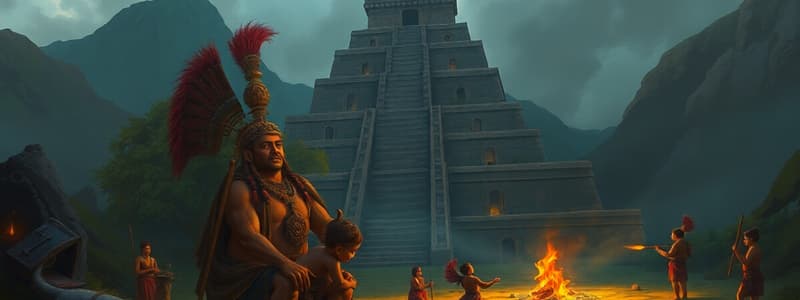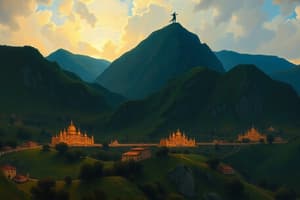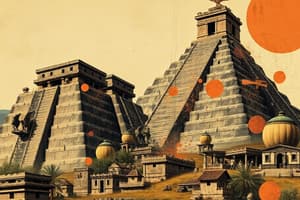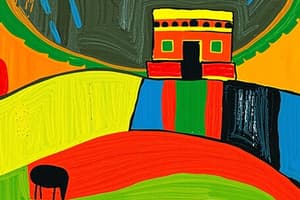Podcast
Questions and Answers
What is the primary focus of Johan Reinhard's research?
What is the primary focus of Johan Reinhard's research?
- Ancient Incan architecture
- People's beliefs about mountains (correct)
- Climate change in the Andes
- The history of the Inca civilization
The mummies uncovered by Johan Reinhard date back to the time of the Aztecs.
The mummies uncovered by Johan Reinhard date back to the time of the Aztecs.
False (B)
What type of ritual is described as taking place high in the Andes?
What type of ritual is described as taking place high in the Andes?
Deadly mountaintop ritual
Johan Reinhard has been exploring Andean peaks for nearly _____ years.
Johan Reinhard has been exploring Andean peaks for nearly _____ years.
Match the following individuals and themes with their corresponding descriptions:
Match the following individuals and themes with their corresponding descriptions:
What was the purpose of the El Plomo boy's sacrifice?
What was the purpose of the El Plomo boy's sacrifice?
The El Plomo boy was discovered in the year 2000.
The El Plomo boy was discovered in the year 2000.
What evidence suggests that the El Plomo boy was alive when he reached the mountaintop?
What evidence suggests that the El Plomo boy was alive when he reached the mountaintop?
What was one of the significant reasons for the Incas' success in conquest?
What was one of the significant reasons for the Incas' success in conquest?
The El Plomo boy is also known as a _______ cocha sacrifice.
The El Plomo boy is also known as a _______ cocha sacrifice.
Match the following items with their descriptions:
Match the following items with their descriptions:
The Incas practiced mountain worship primarily by remaining at the base of the mountains.
The Incas practiced mountain worship primarily by remaining at the base of the mountains.
What was the primary purpose of the capa cocha ritual among the Incas?
What was the primary purpose of the capa cocha ritual among the Incas?
The Incas' kingdom stretched from __________ to __________, rivaling the size of the Roman Empire.
The Incas' kingdom stretched from __________ to __________, rivaling the size of the Roman Empire.
Match the following Inca practices or beliefs with their descriptions:
Match the following Inca practices or beliefs with their descriptions:
What was the primary aim of Catholic monks when they came to the Andes?
What was the primary aim of Catholic monks when they came to the Andes?
Andean traditions completely disappeared after the arrival of the Spanish monks.
Andean traditions completely disappeared after the arrival of the Spanish monks.
What ceremonial offering is made to the mountain before excavation?
What ceremonial offering is made to the mountain before excavation?
Looters are also referred to as __________ in the content.
Looters are also referred to as __________ in the content.
Match the following types of Inca artifacts with their descriptions:
Match the following types of Inca artifacts with their descriptions:
Why were artifacts found on the surface problematic for archaeologists?
Why were artifacts found on the surface problematic for archaeologists?
The mountains in the Andes are considered alive by the villagers.
The mountains in the Andes are considered alive by the villagers.
What happens when the workers on the excavation site find an object?
What happens when the workers on the excavation site find an object?
The freezing conditions in the excavation site make uncovering artifacts very __________.
The freezing conditions in the excavation site make uncovering artifacts very __________.
What psychological impact does the popular fame and publicity have on looters?
What psychological impact does the popular fame and publicity have on looters?
Flashcards are hidden until you start studying
Study Notes
Ice Mummies: Frozen in Heaven Documentary
- The documentary explores the mysteries of Inca child sacrifices in the Andes mountains.
- The main focus is on the research of anthropologist Johan Reinhard who has been studying Andean mountains for over 16 years.
- Reinhard is searching for Inca ruins on Mount Sara Sara in southern Peru.
- The Incas believed that mountains held supernatural powers and were key to their cosmology.
- The Inca Empire ruled the Andes for 500 years and extended from Ecuador to Chile, rivaling the size of the Roman Empire.
- The Incas were known for their architectural achievements, including Machu Picchu.
- William Conklin, an Inca scholar specializing in textiles, believes that the Incas were clever imperialists, using persuasion and incorporating conquered tribes into their empire.
- The Incas, unlike previous Andean cultures, believed in climbing to the top of mountains for religious rituals.
- Reinhard's team discovers Wari artifacts and human remains in a cave on Mount Sara Sara, which predate the Inca civilization.
- Reinhard's team finds Inca ruins on the summit of Mount Sara Sara, including a staging area used for journeys up the mountain.
- The documentary raises questions about the accuracy of Spanish chronicles, which are the main source of information about the Incas.
- Sonia Guillen, a leading expert on mummified bodies, believes that the Spanish chronicles exaggerate some aspects of Inca practices.
- The El Plomo boy, an Inca child mummy found in 1954 on a mountaintop in Chile, provides evidence of the Inca ritual of capa cocha, the sacrifice of children to the mountain gods.
- The El Plomo boy's body was well adorned with Inca textiles and jewelry, including small pouches containing his baby teeth and nail clippings.
- Dr. Silvia Quevedo Kawasaki, a conservationist from Peru, describes the El Plomo boy’s body as being well preserved and still embodying the energy of the people who sacrificed him to the gods.
- The documentary highlights the distinction between Inca human sacrifice and that of other civilizations like the Aztecs, emphasizing that Inca sacrifices were done in a highly ritualized manner.
- The Incas believed that children were pure and considered them to be the best emissaries to the deities.
- The Spanish chroniclers detail the ceremonies involved in the capa cocha ritual, including the long journeys that children took to the mountains.
- The El Plomo boy's body shows signs of a long journey, including calluses on his feet, swollen feet, and frost-bitten fingers.
- Johan Reinhard discovered Juanita, a frozen girl, on Mount Ampato in 1995, providing further evidence of child sacrifice.
- The documentary highlights the challenges of working on Mount Sara Sara at high altitudes and in difficult conditions.
- Reinhard’s team encounters frozen gravel and rock hard conditions, hampering their excavation efforts.
- The team discovers silver Inca shawl pins on the surface of the ground, suggesting that the site may have been looted.
- The documentary explores the issue of huaqeros, grave robbers who loot ancient Inca artifacts and desecrate graves.
- The documentary concludes with a discussion of the impact of Spanish conquest on Inca traditions, including the destruction of sacred sites and the suppression of ancient beliefs.
- The documentary suggests that Inca traditions have merged with Christian beliefs, creating a unique blend of religious practices in the Andes.
- The documentary demonstrates a shift in perspective, encouraging viewers to see the Andes mountains as living entities, as the villagers do.
Inca Child Sacrifice
- Inca burials are often found in remote and inaccessible locations.
- Looting is a major threat to these sites.
- Dynamite has been used to access artifacts in some burials.
- An ear was discovered in a wall at 20,000 feet, blown off by looters.
- Ancient artifacts are very valuable and highly sought after.
- Excavations at Sara Sara, a mountain peak in the Andes, were attempting to find and conserve Inca burial sites.
- Excavations were hampered by difficult weather conditions, including a fierce lightning storm.
- Mountain peaks in the Andes were considered sacred by the Inca, and offerings were made to appease the mountain gods.
- Grass and trees do not grow at high altitudes, so they must have been carried up the mountain, likely by the Incas.
- One well-preserved capa cocha child, a young boy, was found on Mount Aconcagua, the tallest peak in the Western Hemisphere.
- The Aconcagua boy's body was found with achiote, a red dye, in his intestines and vomit, suggesting he was distressed in his last moments.
- The Aconcagua boy was tightly wrapped in textiles, causing broken ribs and a dislocated pelvis.
- The El Plomo boy from Chile was found in a peaceful state, indicating different burial sacrifices.
- Juanita, a capa cocha mummy discovered on Mount Ampato, was CAT scanned, revealing a skull fracture on the right side of her head.
- The CAT scan suggests Juanita was killed by a blow to the head, likely with a rock or a club.
- Juanita's internal organs and textiles will help scientists learn about her life and her culture.
- Juanita's tomb, originally a ceremonial burial place, had been destroyed by landslides, and her body had rolled down the mountain.
- Johan Reinhard, the archaeologist leading the excavation, hoped that the perfect capa cocha burial would be found at Sara Sara.
- A silver llama figurine was found on the main platform at Sara Sara, suggesting the possibility of a burial underneath.
- A female silver statue was found, mirroring the designs used in previous Capa Cocha discoveries.
- Seven artifacts were found on the mountain, including silver and gold figurines.
- A seashell llama figure, made from a spondylus shell found in Ecuador, suggests trade routes used by the Incas.
- A mummy was found in a tomb on the eastern side of Sara Sara, along with offerings and textiles.
- The mummy was identified as female by the presence of a shawl pin.
- The mummy, named Sarita, was dressed in everyday clothing, suggesting she was not of royal lineage.
- Sarita was found to be approximately fifteen years old, older than originally estimated.
- X-rays revealed that Sarita, like Juanita, was killed by a blow to the head.
- The discoveries at Sara Sara provide more information about the capa cocha practice.
- Capa cocha children were chosen for sacrifice to appease the emperor and the mountain gods.
- The children traveled to sacred peaks, reaching great heights before being sacrificed.
Studying That Suits You
Use AI to generate personalized quizzes and flashcards to suit your learning preferences.




